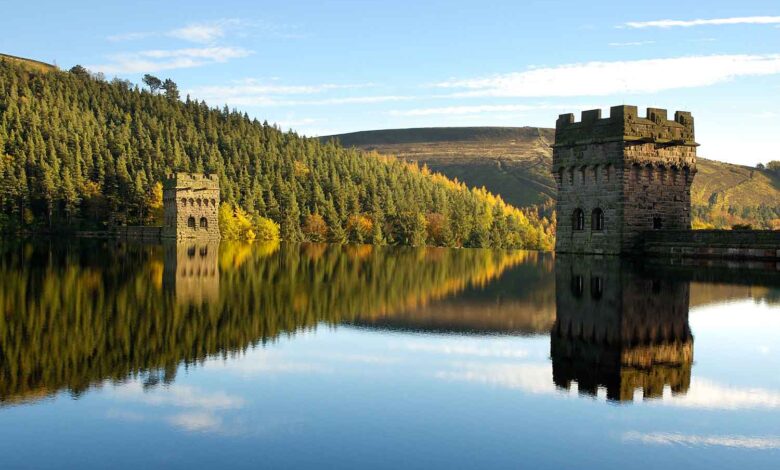Peak District National Park

Discovering the Peak District National Park
The Peak District National Park is one of England’s most cherished landscapes, offering a rich tapestry of natural beauty, history, and outdoor adventures. Located in the heart of the the country, this park draws millions of visitors each year who come to walk its trails, explore its dales and moors, and enjoy its scenic views.
In this article, you will learn about the geography, wildlife, history, key attractions, and tips for visiting the Peak District National Park.
1. Location and Size
- The Peak District National Park covers about 555 square miles (1,438 km²). (Peak District National Park)
- It spans parts of several counties: Derbyshire, Cheshire, Staffordshire, Yorkshire, and Greater Manchester.
- It is among the most accessible national parks in Britain, being close to major cities like Manchester, Sheffield, Nottingham, and Derby.
2. Landscape and Geology
The Peak District National Park features a remarkable contrast of landscapes:
- Dark Peak: This northern and outer region is characterized by moorland, gritstone edges, and peat bogs. (Peak District National Park)
- White Peak: In the central and southern areas, limestone dales, rolling hills and pastures dominate. (Peak District National Park)
Geologically, the area is mostly composed of Carboniferous sedimentary rock (limestone, gritstone, shale), and over time erosion and uplift have shaped distinctive valleys, caves, and escarpments. (Kiddle)
The highest point in the park is Kinder Scout, rising to about 636 metres (2,087 feet). (Peak District National Park)
3. Wildlife and Habitat
The Peak District National Park supports a variety of habitats and species:
- Upland moorland, hay meadows, woodland, and calcareous grasslands are among its major habitat types. (Campaign for National Parks)
- You might spot red deer, mountain hares, golden plovers, and birds of prey such as owls. (Campaign for National Parks)
- The park is recognized for its “special qualities,” including dark night skies, diverse wildlife, tranquil areas, and landscapes shaped over centuries of human activity. (Peak District National Park)
Because it is not purely wilderness but a lived-in landscape, there are farms, villages, and historic features integrated into the environment. (Peak District National Park)
4. History and Cultural Significance
- The Peak District National Park was officially designated on 17 April 1951 as the first national park in Britain. (Peak District National Park)
- However, its roots as a protected area stem from earlier movements for public access. The 1932 Kinder Mass Trespass was a landmark protest by walkers who challenged access restrictions on moorland, helping to shape later national park legislation. (Campaign for National Parks)
- Over time, the Peak District became a symbol of countryside access rights in the UK. (National Parks)
- The area is also rich in cultural heritage: ancient stone circles, old mining sites, historic houses and rural villages are woven throughout the landscape. (Peak District National Park)
5. Attractions & Activities
Walking, Hiking & Trails
The Peak District National Park has more than 1,600 miles of public footpaths, bridleways, and tracks, making it a walker’s paradise. (Phil Sproson Photography)
One famous route is the Pennine Way, which begins in the park at Edale and stretches northward. (National Parks)
Caves & Limestone Features
In the White Peak areas, you’ll find caves, sinkholes, and limestone formations. Examples include Blue John Cavern and Treak Cliff Cavern. (VisitBritain)
Scenic Dales and Valleys
Dovedale is a particularly beautiful valley in the Peak District, with stepping stones across the River Dove and limestone cliffs. (Wikipedia)
Historic Houses & Estates
Places like Chatsworth House lie within or adjacent to the park and attract many visitors for their gardens, architecture, and art collections. (PeakDistrict.org)
Cycling, Climbing, and More
Mountain biking, rock climbing, caving, and even gliding are popular activities in the park. (National Parks)
Converted railway tracks now serve as traffic-free trails, making it easier to access remote areas. (Peak District National Park)
6. Challenges and Conservation
Managing a high-use landscape like the Peak District National Park comes with challenges:
- Visitor pressure: Around 13 million people visit annually, putting stress on paths, parking, and fragile habitats. (Peak District National Park)
- Erosion & habitat damage: Foot traffic, wildfires, and land use changes threaten sensitive moorlands and peat bogs. (The Guardian)
- Balancing farming and nature: Much of the land is privately owned and used for grazing or agriculture, so conservation efforts must work with landowners. (Wikipedia)
- Climate change: Warmer weather and drier conditions increase risks of moorland fires. (The Guardian)
Park authorities, conservation groups, and communities collaborate to protect and restore habitats, manage visitor flow, and maintain the park’s natural and cultural heritage. (Peak District National Park)
7. Tips for Visiting
- Plan your visit outside peak weekend times to avoid crowds.
- Use official car parks and avoid illegal parking (which has become a concern, especially around popular viewpoints). (The Guardian)
- Stick to designated trails to reduce erosion and protect flora.
- Be aware of fire risks—do not light fires or drop litter, especially in dry conditions. (The Guardian)
- Check public transport options: some valleys and villages are accessible by bus or train, reducing the need to drive. (National Parks)
🏞️ Frequently Asked Questions (FAQ) about Peak District National Park
1. Where is the Peak District National Park located?
The Peak District National Park is located in central England. It stretches across several counties, including Derbyshire, Staffordshire, Cheshire, and Yorkshire. It lies between major cities such as Manchester, Sheffield, and Derby, making it one of the most accessible national parks in the UK.
2. Why is it called the Peak District?
Despite its name, the Peak District doesn’t have sharp mountain peaks. The term “Peak” comes from the Pecsaetan, an Anglo-Saxon tribe that once lived in the area. The landscape is mostly made up of rolling hills, valleys, and moorlands.
3. When was the Peak District National Park established?
The Peak District National Park was officially designated on 17 April 1951, making it the first national park in the United Kingdom.
4. What is the highest point in the Peak District?
The highest point in the park is Kinder Scout, which rises to 636 metres (2,087 feet) above sea level. It’s a popular destination for hikers and offers stunning panoramic views.
5. What are the main areas of the Peak District?
The park is divided into two main regions:
- Dark Peak – Northern area with wild moorlands and gritstone edges.
- White Peak – Southern area with limestone valleys and green pastures.
6. What wildlife can you see in the Peak District National Park?
Visitors may encounter red deer, mountain hares, buzzards, skylarks, and owls. The moorlands and woodlands support a wide range of plant and animal species, making it a paradise for nature lovers.
7. What are the most popular attractions in the Peak District?
Some must-visit attractions include:
- Chatsworth House – A grand stately home with gardens and art collections.
- Dovedale – Famous for its scenic stepping stones and limestone cliffs.
- Blue John Cavern – A beautiful cave known for its rare Blue John stone.
- Mam Tor – A popular hill for walking and photography.
8. What activities can you do in the Peak District?
You can enjoy hiking, cycling, rock climbing, caving, photography, and wildlife watching. The park also offers scenic drives, camping sites, and family-friendly picnic spots.
9. Is the Peak District National Park free to visit?
Yes! Entry to the Peak District National Park is completely free, though some attractions (like caves or houses) may charge an admission fee. Parking and guided tours may also have small charges.
10. What is the best time to visit the Peak District?
The park is open all year round. However:
- Spring and summer (April–August) are best for hiking and enjoying wildflowers.
- Autumn brings beautiful colours across the moors.
- Winter is perfect for quiet walks and misty, dramatic views.
11. Can you stay overnight in the Peak District?
Yes. There are plenty of hotels, guesthouses, cottages, and campsites throughout the park. Towns like Bakewell, Buxton, and Castleton are popular bases for exploring.
12. Why is the Peak District National Park important?
The park plays a vital role in preserving nature, promoting sustainable tourism, and protecting cultural heritage. It also provides clean water, natural habitats, and recreational space for millions of people every year.



